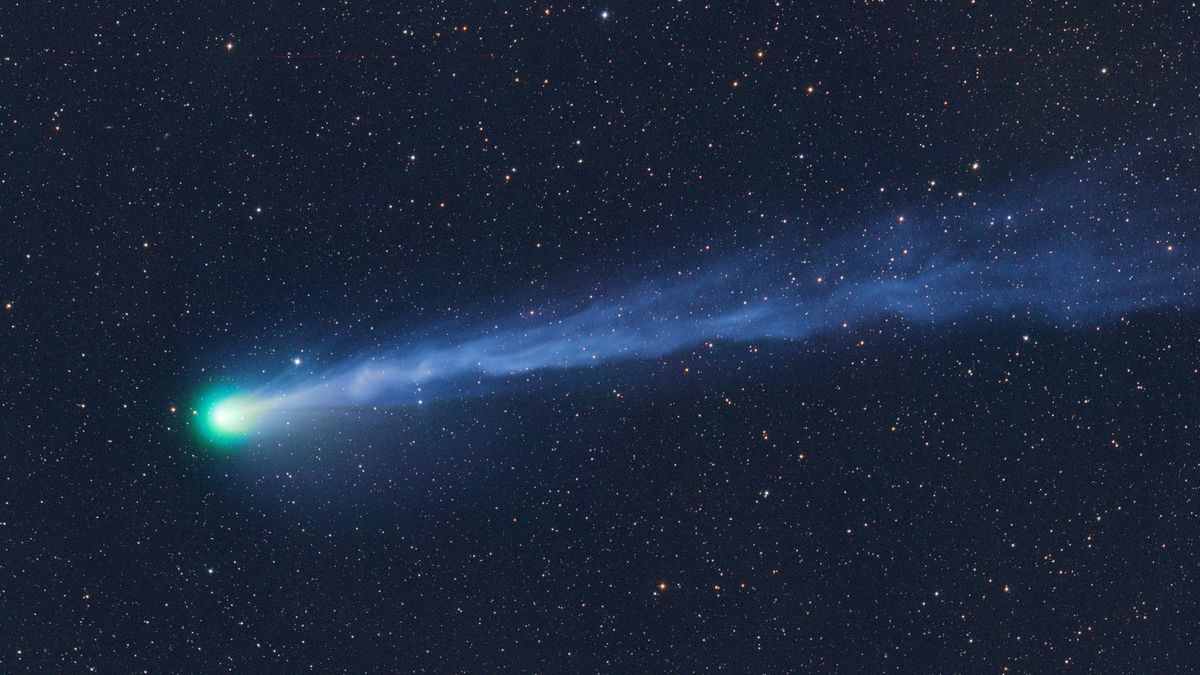On April 8, 2024, a rare celestial event will unfold in the skies above North America as the Great North American Total Solar Eclipse takes place. Among the cosmic phenomena accompanying this spectacle is the elusive “Devil Comet,” officially known as Comet 12P/Pons-Brooks.

Also Read: SpaceVIP Unveils the World’s First Michelin-Starred Meal in Space
Skywatchers and astronomers are anticipating the upcoming celestial spectacle as the rare “devil comet,” officially known as Comet 12P/Pons-Brooks, prepares for its closest approach to Earth in 71 years.
Comet 12P/Pons-Brooks, named after astronomers Jean-Louis Pons and William Robert Brooks who first observed it in 1812, is a massive cryovolcanic object with periodic explosions that give it an appearance resembling devil horns or even the Millennium Falcon spacecraft from “Star Wars.”
The comet has an orbital period of 71 years, similar to Halley’s Comet, and is categorized as a short-period comet.
Estimated to be at least 17 kilometers (10.5 miles) in diameter, Comet 12P/Pons-Brooks has no danger to Earth during its closest approach. Recent observations indicate multiple outbursts since July 2023.
The comet is set to reach perihelion, its closest approach to the Sun, on April 21, coinciding with the total solar eclipse on April 8.
Skywatchers will have an opportunity to observe Comet 12P/Pons-Brooks during the eclipse, provided they are in the path of totality and equipped with binoculars or telescopes.
Following perihelion, the comet will make its closest approach to Earth on June 2, another chance for observation before it shifts to the southern night sky.
Currently visible in the early evening sky from the Northern Hemisphere, the comet may become brighter as it approaches perihelion.
Observers are advised to locate Comet 12P/Pons-Brooks in the low northwestern sky, away from city lights, and allow their eyes to adjust to the darkness for optimal viewing.
Also Read: Scientists have Discovered a Giant Volcano on Mars
During the total solar eclipse, the comet will be approximately 25 degrees away from the Sun and may be visible alongside other celestial bodies.
Recent observations suggest that heat from the Sun triggers vaporization of material inside the comet, leading to eruptions and the formation of distinctive features.
Comet 12P/Pons-Brooks, discovered by French astronomer Jean-Louis Pons in 1812, is a short-period comet with an orbital period of approximately 71 years.
Its nucleus, estimated to be around 20 miles (32 kilometers) wide, makes it a cosmic object, comparable in size to Halley’s Comet.
This cosmic wanderer last graced Earth’s vicinity in 1954, and its current visit promises to captivate astronomers and stargazers alike.
Recent observations of Comet 12P/Pons-Brooks have revealed a series of outbursts, starting from July 2023, which have intensified its brightness and altered its appearance.
These outbursts, by sudden increases in brightness and the formation of horn-like structures, have intrigued scientists and amateur astronomers alike.
Also Read: New Zealand: Scientists Discovered 100 New Marine Species
The comet’s appearance during these eruptions has drawn comparisons to iconic imagery from popular culture, such as the Millennium Falcon from “Star Wars.”
The upcoming total solar eclipse on April 8 offers a rare opportunity for skywatchers to witness the convergence of two extraordinary celestial events.
While the eclipse itself promises to engulf parts of North America in darkness, providing a viewing experience, Comet 12P/Pons-Brooks may also be visible during this period.
Although its visibility during totality remains uncertain, astronomers suggest that observers may catch a glimpse of this cosmic traveler alongside the eclipsed sun.
Observing Comet 12P/Pons-Brooks requires careful planning and optimal viewing conditions. Skywatchers in the Northern Hemisphere can currently spot the comet in the early evening sky, particularly in the Pisces constellation.
To enhance visibility, astronomers recommend seeking dark, unobstructed skies away from city lights and using binoculars or telescopes for better clarity.
Additionally, during the total solar eclipse, skywatchers may have the opportunity to observe the comet alongside other celestial bodies, provided they are within the path of totality.
By studying its behavior, structure, and composition, researchers hope to gain insights into the dynamics of cometary activity and the formation of our solar system.
Also Read: Odysseus Completes First US Moon Landing Since 1972























